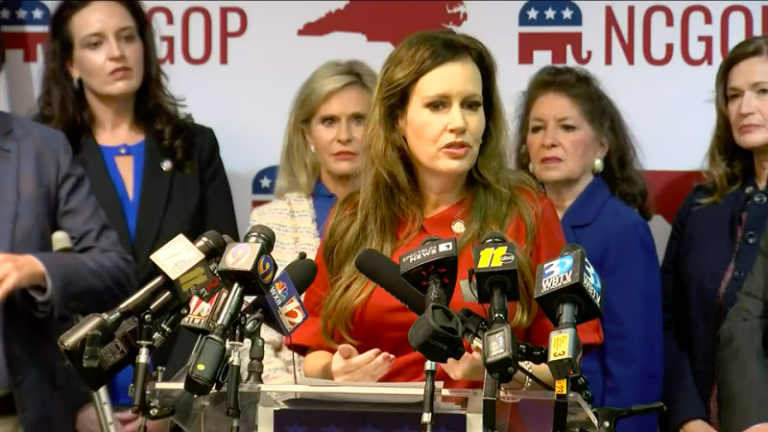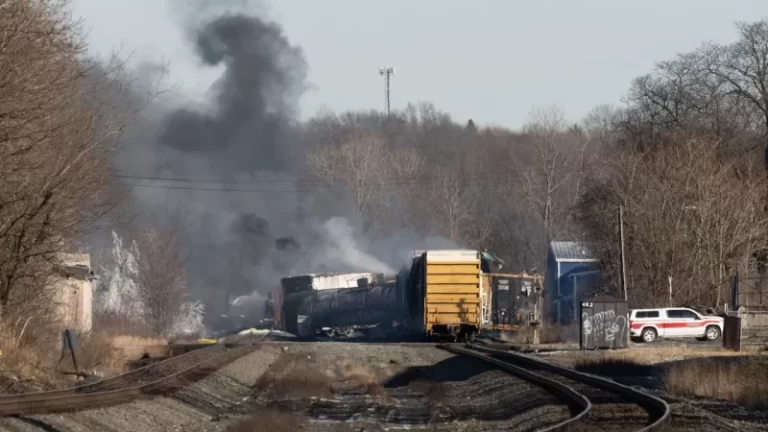Republicans in North Carolina are sensing momentum as they look to push forward a wide-ranging legislative agenda with an extra pep in their step after a Democratic lawmaker changed parties this week, giving the GOP a veto-proof supermajority in the state House.
North Carolina state Rep. Tricia Cotham announced Wednesday that she is joining the Republican Party after long serving her deep blue Charlotte-area district as a Democrat. Beyond being symbolically important, the announcement could have a profound effect on the Tar Heel State.
While North Carolina Republicans have held majorities in both the state’s House and Senate chambers for years, the threat of a veto from Democratic Gov. Roy Cooper has prevented them from implementing much of their agenda. But Cotham’s decision to join the GOP gives Republicans a clear path with a veto-proof majority in the House — complementing the GOP supermajority in the state Senate — to push a wide range of legislation without necessarily needing to compromise with Cooper.
‘If it’s a hot topic in American politics, the North Carolina General Assembly likely has a bill dealing with it,’ said Christopher Cooper, a professor of political science and public affairs at Western Carolina University.
‘Transgender rights, election law, abortion, the role of critical race theory in schools are all issues the General Assembly has on its plate. If that’s not enough for you, there’s even a bill attempting to get rid of participation trophies in youth sports. We don’t know which bills will die a quiet death and which will make it out of the General Assembly. But, thanks to Tricia Cotham’s party switch, we know that the Republicans don’t need a single Democratic vote to enact the policies they want.’
Republicans didn’t waste time with their new veto-proof legislative majorities, introducing a flurry of bills this week focusing on transgender issues that were previously dead on arrival. Two of the bills would ensure athletes play on sports teams only with their own sex, which would be based on reproductive biology and genetics at birth.
‘My sense is that we may see various efforts come to pass in North Carolina as in other majority Republican legislatures, such as policies related to transgender, education reform (especially since Rep. Cotham chairs that committee), likely revisions of election and voting laws (such as requiring mail-in ballots delivered by Election Day, rather than three days afterward), and certainly one of the most controversial, abortion,’ said Michael Bitzer, a professor of politics and history at Catawba College.
‘We may also see some topics previously vetoed by the governor return to consideration. Most of us are in a ‘wait and see’ mode when it comes to the exact policies and legislation proposed, but it feels like the Republicans have carte blanche to do what they want, based on caucus and chamber unity.’
The legislature will also look into school choice, parental involvement in schools, and redrawing congressional districts, according to experts on North Carolina politics.
‘The GOP will push through significant bills on education choice and parental involvement in schools. I believe Cotham will be on board with a lot of these forthcoming bills,’ said Chris Sinclair, a political strategist in North Carolina. ‘Finally, I believe the legislature will revisit the congressional and legislative maps and redraw these maps as has been speculated. They don’t need the governor for this, but believe they will draw a district for Cotham that is more competitive for an R than her current district, and she will support these new maps.’
However, Republicans, who had been just one seat shy of a supermajority, were already pursuing many of these agenda items before Cotham’s announcement, working with moderate Democrats to pass legislation.
‘I can honestly state that I am unaware of any change whatsoever in the issues we as a Republican Caucus intend to pursue,’ said Republican state Rep. Kristin Baker, the House deputy majority whip. ‘Our values, and our objectives, remain unaltered.’
Rep. Jason Saine, the House GOP caucus leader, echoed that point, outlining some of what’s on the agenda for his conference.
‘Coming into this year’s session, Republican leadership in the North Carolina House was already working with pragmatic Democrats to push for legislation that would limit emergency powers of the governor after school children, families, and small businesses suffered under his power grab during COVID,’ said Saine. ‘Much of what we can accomplish with a supermajority was already in play given that there are several Democrats who are working with us on a number of policy reforms.’
‘Expansion of school choice, election law reforms, as well as many other issues are still being discussed and planned,’ Saine continued. ‘Having just completed the House budget proposal and receiving the vote of nine Democrats on our budget bill, which also included a number of policy reforms, we think we are in a good place to continue to move our agenda forward.’
The state House on Thursday approved a two-year budget plan that now goes to the Senate for a vote.
‘The really big battle in North Carolina will be over the budget, and I suspect that it is here, in particular, that Cotham’s switch will have the most dramatic impact,’ said Steven Greene, a professor of political science at North Carolina State University. ‘So much of the partisan conflict in North Carolina comes out in the budget, and it is very often a party-line vote. I don’t think Cotham would have switched parties if she were not willing to vote with the Republicans on the budget, so, that alone, is a very big deal.’
However, Cotham may not be a sure yes vote when it comes to some GOP legislation, according to experts and lawmakers who note she doesn’t fall neatly into any one political box.
‘No doubt that Rep. Cotham’s decision to join the Republican Party was a seismic shift in North Carolina state politics,’ said Sinclair. ‘However, Rep. Cotham made it clear to everyone that she is an independent thinker. I don’t see her being a certain yes on all the GOP leadership’s legislative and policy considerations. Her switch doesn’t mean a blank check for everything under consideration by GOP leaders in the House.’
Greene cited in particular ‘Cotham’s history on LGBT issues’ as an indication she doesn’t seem an automatic vote for the full Republican agenda. Cotham’s Republican colleagues agreed with that conclusion — and seemed to embrace it.
‘Rep. Cotham has clearly stated that she is the same person; therefore, her approach to evaluating issues has not changed,’ said Baker. ‘Diversity of thought must not just be tolerated; it must be encouraged. And if we use this event to elevate that message, we will have served our citizens well.’
Saine similarly argued that Cotham may not agree with other House Republicans on everything but quickly added that, either way, ‘wokeism’ is dead in North Carolina.
‘The addition of Rep. Cotham to our caucus is a factor, but the fact of the matter remains, she has always been a very pragmatic legislator that has been willing to cross party lines,’ he said. ‘I am glad that she is now in a party that appreciates her independence and leadership. The bottom line is that ‘wokeism’ is finding a dead end in our state, and we will continue to push for policies that really matter to our people. We aren’t California, and we don’t want to be.’
Beyond Cotham’s own policy views, another factor for Republicans will be governing in such a way to put them in a strong position for 2024.
‘The question will be which bills leadership allows to the floor. While there is a super majority, leadership will be focused on an issue agenda that allows them to keep and expand that majority in the 2024 elections,’ said Paul Shumaker, a political strategist in North Carolina.
According to some experts, however, the GOP’s newfound supermajority may prove problematic if they don’t deliver for North Carolinians.
‘There’s no doubt the GOP had a good week in North Carolina,’ said Sinclair. ‘What they do with their new member and how far they go on issues will be critical — and they must be mindful of how far they go and will want to talk to their colleagues in Wisconsin and Kansas on how right they shift on key issues — especially on abortion. If they go too far, their newfound power could be short-lived after 2024, even with new maps.’
Aaron Kliegman is a politics reporter for Fox News Digital.
This post appeared first on FOX NEWS










